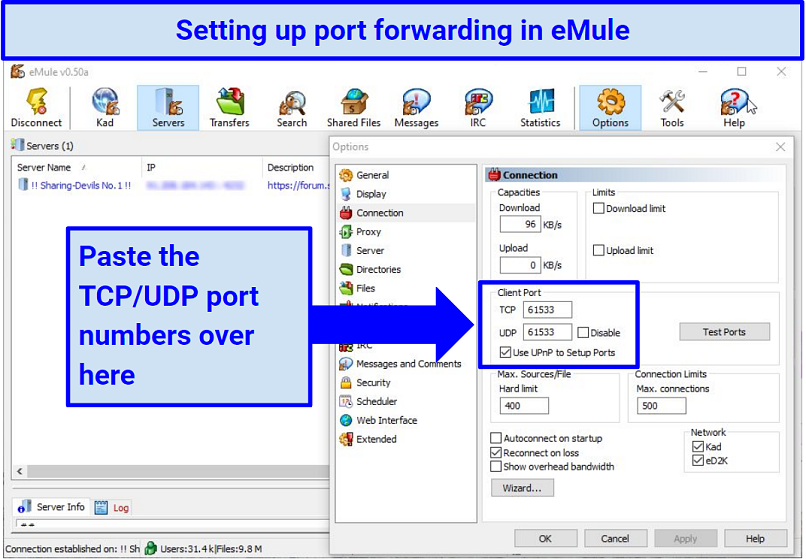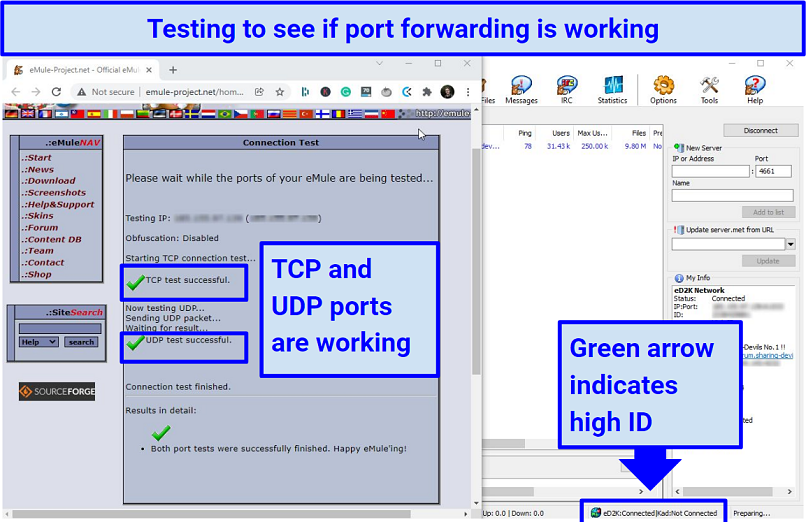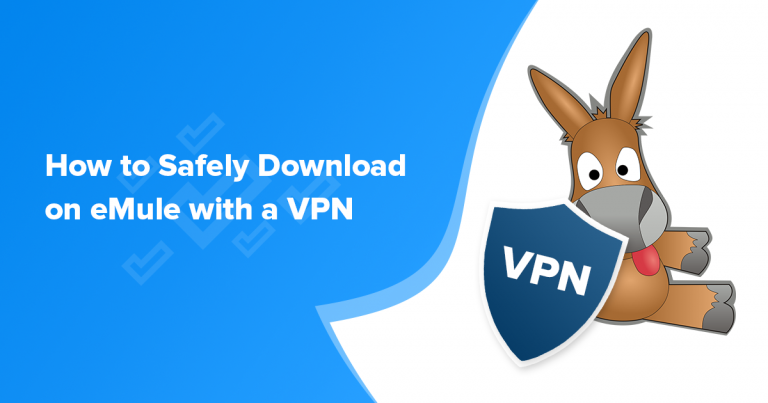How to Safely Download on eMule with a VPN in 2025
Whenever you’re using eMule, the peers in your swarm can see vulnerable information about you, such as your actual location and IP address. Hackers and copyright trolls can then use this information to target you specifically.
The best way to protect yourself is by using a virtual private network. A VPN hides your real IP address and browsing activity, so your ISP (internet service provider) cannot see that you’re using eMule, and peers can't see your IP or location. However, not all VPNs are up for the task — some aren’t secure enough to keep you protected.
Quick Guide: How to Safely Download on eMule in 3 Easy Steps
- Download a VPN.
- Connect to a server that's close to your real location. A nearby server will give you the best speeds.
- Start downloading on eMule. With the VPN turned on, you’ll stay safe while using eMule.
Why You Need a VPN for eMule
The problem with eMule is that anyone who’s downloading or uploading the same file as you can see your IP address and actual location. Data brokers, hackers, and copyright trolls may use this information in various money-extortion schemes.
Another problem is that ISPs can see everything you do online, including torrenting. When your ISP detects that you’re using eMule, it most likely throttles your internet connection.
VPNs protect you from this. They mask your IP address and location, so that you remain anonymous while you're torrenting. VPNs also encrypt your connection, ensuring that your ISP cannot see your browsing data (for example, that you’re torrenting).
Not all VPNs are great for eMule, though. Some don’t allow torrenting altogether or have slow download speeds, and others keep logs of your browsing activity. A VPN also needs to allow port forwarding to get fast download speeds on eMule. I tested multiple VPNs to see how well they work with eMule, and down below, I’ve listed the best ones.
My team and I don't condone torrenting copyrighted material. Torrenting is banned in some countries, so you should check your local regulations before using eMule.
How to Set up Port Forwarding for eMule
- Get a VPN.
- Turn on port forwarding for your VPN and copy the port numbers. Some VPNs allow you to do this through their apps, and others let you do that only through their website. Once you’ve turned on port forwarding, copy the 5-digit numbers for TCP and UDP ports.
- Switch to open ports on eMule. Open eMule, go to the “options” tab, click on “connection,” uncheck “Use UPnP to Setup Ports,” then paste the open TCP and UDP ports from your VPN, and finally click “apply.”
 You can enter the UDP and TCP ports by opening the Options tab on the eMule client
You can enter the UDP and TCP ports by opening the Options tab on the eMule client - Ensure that port forwarding is working. Click on the “Test Ports” button in the connection settings to see if you have a “high ID.” You can also look at the globe icon with 2 arrows at the bottom of the window: yellow arrow indicates “low ID” and green “high ID” (only works when connected to a server).
 You can test if port forwarding is working by clicking the “Test Ports” button in the Options tab
You can test if port forwarding is working by clicking the “Test Ports” button in the Options tab - If you still have a low ID, disable your firewall. This will most likely fix any issues, but you could also try disabling your antivirus.
FAQs on Downloading on eMule with a VPN
Can I use a free VPN with eMule?
No, the free VPNs I tested didn't work with eMule. Usually, their connection speed is very slow, which means that it takes much longer to download the same file than with a good VPN. In addition to that, free VPNs also aren’t as safe and reliable.
What makes a VPN good for eMule?
Your VPN needs to be fast to ensure the best possible download speeds on eMule. For eMule specifically, it needs to allow port forwarding because, without this, it limits your download speed by roughly 90%. In the best-case scenario, it should also allow torrenting on all of its servers.
There are a few other important features to look out for, such as DNS and IPv6 leak protection. If a VPN is leaking your IP address, your peers will be able to see your real location.
Is eMule safe to use?
eMule is an open-source application, which means anyone can find security flaws and update them. I scanned its installation files for malware, and I didn’t find any. It’s not unusual for my antivirus to block torrenting clients due to malware risks, but I didn’t get any warnings when installing eMule.
That said, torrenting in itself can be dangerous. To stay safe, you need to download files with many sources (peers), and before opening a downloaded file, scan it with your antivirus. In addition to that, you should also use a VPN to hide your IP address so that other people downloading the same file as you can't see your IP and location.
Why did I get low ID on eMule?
eMule sorts its users into “low ID” and “high ID” based on their ability to upload torrents. If you can’t upload torrents, eMule will put you in the “low ID” category, and your download speeds will be about 80% to 90% slower.
This usually happens due to firewalls blocking TCP and UDP ports, which are needed to upload on eMule. Open TCP and UDP ports are considered security threats, so firewalls block them. That’s why getting a “high ID” on eMule isn’t necessarily a good thing if you’re concerned about security.
Usually, disabling your computer’s firewall will fix this issue. However, if you’re using a VPN, it has an additional NAT firewall, which can’t be disabled. Instead, some VPNs offer port forwarding, which opens up specific ports to bypass the NAT firewall. So, if you want to get a “high ID” while using a VPN with eMule, get a VPN that supports port forwarding.
Start Downloading Safely on eMule Now
If you want to download safely on eMule without being monitored by your ISP and copyright trolls, you need to use a VPN. And not just any VPN because it needs to allow port forwarding to get fast download speeds on eMule.




Please, comment on how to improve this article. Your feedback matters!